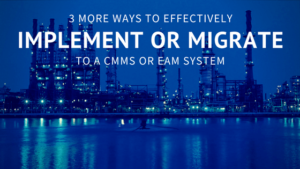When you have a massive project sitting in front of you, it may seem overwhelming in the beginning. Breaking the task down into smaller sections and taking it one step at a time makes it more manageable. At first, an EAM migration might appear to be a lengthy and challenging process. You might be unsure about how your new system will be configured. What you should know, is much of that depends on your data migration plan and maintenance strategy.
Lack of planning and scheduling could leave you spending more time than anticipated on your data migration project. So how can you arrange your data in a way that is easy to manage?
Simplicity is key
Asset-intensive organizations typically have complex data structures that are essential for the operation of their business. Understanding all this data is already tricky, and if this data is disorganized or inaccurate it becomes even more difficult. Planning is a very important first step in the execution of any project. This same principle is very much applicable to data migrations.
A significant aspect of planning your migration will include staging and visualizing your data in an asset hierarchy. This makes it much easier for you to break the project down into smaller segments and reorganize the data according to new standards and maintenance strategies.

Double check, then triple check
Reviewing your data before uploading it into your new EAM system carries the same importance as planning and scheduling. This is the opportunity for you to double check and triple check. Once again, visualizing your data in an asset hierarchy becomes extremely useful.
In addition to ensuring you are keeping up with new asset maintenance standards, you are also reducing the risk of poor quality data lingering in your new EAM system. This leads to increased clarity and less frustration trying to work with a disorganized data structure.
Optimizing for the future
The more detailed your plan is, the more value you will get from your new EAM system. Patience, planning, and reviewing are each important steps to take when mapping out your asset and maintenance data migration. After all, why invest in new technology only to have the same problem you dealt with prior? A big part of eliminating those chances is doing everything in your power to simplify complex data to become more user-friendly. If you are planning an EAM data migration and need assistance working with complex data, feel free to book a demo with our team and we would be happy to get in touch with you!
7 Effective Steps to Implementing & Migrating Your CMMS System
Planning an EAM Migration: Asking the Right Questions
3 More Ways to Effectively Implement or Migrate to a CMMS or EAM System
Share this article




